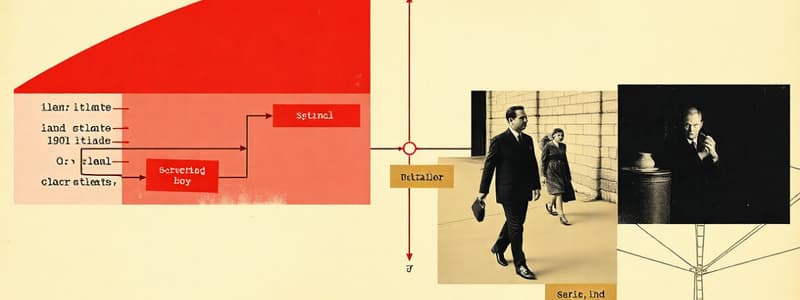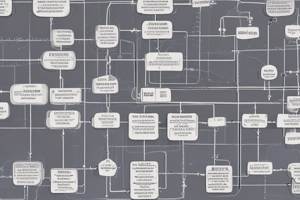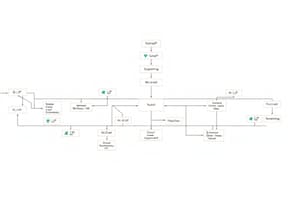Podcast
Questions and Answers
What is the primary purpose of the 'enterItem(itemId, quantity)' function in the process sale scenario?
What is the primary purpose of the 'enterItem(itemId, quantity)' function in the process sale scenario?
Which step in the process sale scenario directly involves customer interaction?
Which step in the process sale scenario directly involves customer interaction?
In a System Sequence Diagram, which element signifies a message sent from the Cashier to the System?
In a System Sequence Diagram, which element signifies a message sent from the Cashier to the System?
What is the outcome of the step where the system presents the total with taxes calculated?
What is the outcome of the step where the system presents the total with taxes calculated?
Signup and view all the answers
What is indicated by the term 'main success story' in the use case analysis?
What is indicated by the term 'main success story' in the use case analysis?
Signup and view all the answers
Which function is responsible for recording the sale line item in the process sale scenario?
Which function is responsible for recording the sale line item in the process sale scenario?
Signup and view all the answers
Which step in the process sale scenario is optional and might not always yield a return value?
Which step in the process sale scenario is optional and might not always yield a return value?
Signup and view all the answers
In the Process Sale Scenario, what is the first action the Cashier performs?
In the Process Sale Scenario, what is the first action the Cashier performs?
Signup and view all the answers
What does the System provide after the Cashier completes the sale?
What does the System provide after the Cashier completes the sale?
Signup and view all the answers
Which UML notation is used to depict the interactions between the Cashier and the System in the Process Sale Scenario?
Which UML notation is used to depict the interactions between the Cashier and the System in the Process Sale Scenario?
Signup and view all the answers
What is indicated by the 'loop [more items]' notation in the System Sequence Diagram?
What is indicated by the 'loop [more items]' notation in the System Sequence Diagram?
Signup and view all the answers
Which of the following is a step performed by the System during the payment process?
Which of the following is a step performed by the System during the payment process?
Signup and view all the answers
Which component is NOT part of the Use Case Realizations?
Which component is NOT part of the Use Case Realizations?
Signup and view all the answers
What is the primary role of the Cashier in the Process Sale Scenario?
What is the primary role of the Cashier in the Process Sale Scenario?
Signup and view all the answers
In UML, which type of diagram focuses on the workflow and steps taken during a specific process?
In UML, which type of diagram focuses on the workflow and steps taken during a specific process?
Signup and view all the answers
What aspect of UML is emphasized when discussing the ability to make design decisions?
What aspect of UML is emphasized when discussing the ability to make design decisions?
Signup and view all the answers
What is the primary purpose of a System Sequence Diagram (SSD)?
What is the primary purpose of a System Sequence Diagram (SSD)?
Signup and view all the answers
Which of the following best describes how SSDs are derived?
Which of the following best describes how SSDs are derived?
Signup and view all the answers
In UML notation for SSDs, what does the term 'makePayment(amount)' represent?
In UML notation for SSDs, what does the term 'makePayment(amount)' represent?
Signup and view all the answers
What is indicated by the phrase 'System is treated as a black-box' in the context of SSDs?
What is indicated by the phrase 'System is treated as a black-box' in the context of SSDs?
Signup and view all the answers
Which of the following best captures the interaction steps of the 'Process Sale Scenario'?
Which of the following best captures the interaction steps of the 'Process Sale Scenario'?
Signup and view all the answers
Why are SSDs often drawn for main success scenarios and complex alternative scenarios specifically?
Why are SSDs often drawn for main success scenarios and complex alternative scenarios specifically?
Signup and view all the answers
What role does the 'Cashier' play in the SSD for the Process Sale Scenario?
What role does the 'Cashier' play in the SSD for the Process Sale Scenario?
Signup and view all the answers
What is the significance of specifying intention in event naming, such as 'enterItem(itemId)'?
What is the significance of specifying intention in event naming, such as 'enterItem(itemId)'?
Signup and view all the answers
Which of the following operations is typically performed right after a customer pays?
Which of the following operations is typically performed right after a customer pays?
Signup and view all the answers
What does an asterisk (*) indicate in a System Sequence Diagram's message notation?
What does an asterisk (*) indicate in a System Sequence Diagram's message notation?
Signup and view all the answers
What is the significance of using brackets [] in the message notation for SSD?
What is the significance of using brackets [] in the message notation for SSD?
Signup and view all the answers
Which component is considered a high-level operation triggered by an external input event in SSD?
Which component is considered a high-level operation triggered by an external input event in SSD?
Signup and view all the answers
What does the notation 'return-value := message-name(parameter-list)' represent?
What does the notation 'return-value := message-name(parameter-list)' represent?
Signup and view all the answers
In UML message format, what is the purpose of having all names begin with a lowercase letter?
In UML message format, what is the purpose of having all names begin with a lowercase letter?
Signup and view all the answers
Which diagram types are included in the extending and integrating requirements models?
Which diagram types are included in the extending and integrating requirements models?
Signup and view all the answers
What does the term 'message-name' in SSD indicate?
What does the term 'message-name' in SSD indicate?
Signup and view all the answers
What must every output in a System Sequence Diagram be derivable from?
What must every output in a System Sequence Diagram be derivable from?
Signup and view all the answers
What does the format 'message-name (parameter-list)' indicate in the UML message format?
What does the format 'message-name (parameter-list)' indicate in the UML message format?
Signup and view all the answers
What does the notation '[true/false condition]' signify in a System Sequence Diagram?
What does the notation '[true/false condition]' signify in a System Sequence Diagram?
Signup and view all the answers
In the message notation for SSD, what does the '*' symbol represent?
In the message notation for SSD, what does the '*' symbol represent?
Signup and view all the answers
Which of the following correctly describes a system operation in the context of a black box component?
Which of the following correctly describes a system operation in the context of a black box component?
Signup and view all the answers
What is the primary purpose of using parentheses in the parameter list in a UML message?
What is the primary purpose of using parentheses in the parameter list in a UML message?
Signup and view all the answers
In System Sequence Diagrams, what is the significance of a system's outputs?
In System Sequence Diagrams, what is the significance of a system's outputs?
Signup and view all the answers
What is the role of the return-value in the message notation for SSD?
What is the role of the return-value in the message notation for SSD?
Signup and view all the answers
What do domain classes in extending and integrating requirements models represent?
What do domain classes in extending and integrating requirements models represent?
Signup and view all the answers
Flashcards
Process Sale Scenario
Process Sale Scenario
A scenario describing how a cashier processes a sale; interacting with the system, entering items, calculating totals, and handling payment.
enterItem(itemId, quantity)
enterItem(itemId, quantity)
A message from a cashier to the system, specifying an item and quantity for a sale.
makeNewSale
makeNewSale
An action initiated by the cashier to begin a new sale in the system.
endSale
endSale
Signup and view all the flashcards
total with taxes
total with taxes
Signup and view all the flashcards
makePayment(amount)
makePayment(amount)
Signup and view all the flashcards
item identifier (itemId)
item identifier (itemId)
Signup and view all the flashcards
System Sequence Diagram (SSD)
System Sequence Diagram (SSD)
Signup and view all the flashcards
System Operation
System Operation
Signup and view all the flashcards
External Actor
External Actor
Signup and view all the flashcards
Use Case
Use Case
Signup and view all the flashcards
Process Sale Scenario (SSD)
Process Sale Scenario (SSD)
Signup and view all the flashcards
Event (in SSD)
Event (in SSD)
Signup and view all the flashcards
UML Sequence Diagram Notation
UML Sequence Diagram Notation
Signup and view all the flashcards
Success Scenario
Success Scenario
Signup and view all the flashcards
Conceptual Class System
Conceptual Class System
Signup and view all the flashcards
Use Case Diagram
Use Case Diagram
Signup and view all the flashcards
Use Case Realizations
Use Case Realizations
Signup and view all the flashcards
UML Diagram
UML Diagram
Signup and view all the flashcards
Domain Classes
Domain Classes
Signup and view all the flashcards
Domain Model Class Diagram
Domain Model Class Diagram
Signup and view all the flashcards
Activity Diagram
Activity Diagram
Signup and view all the flashcards
SSD Message Format
SSD Message Format
Signup and view all the flashcards
Outgoing Messages (System Outputs)
Outgoing Messages (System Outputs)
Signup and view all the flashcards
Message Notation in SSD
Message Notation in SSD
Signup and view all the flashcards
Study Notes
System Sequence Diagrams
- A system sequence diagram (SSD) shows the interaction between an actor and the system for a single use case.
- It depicts the system as a black box.
- It includes the initiating actor.
- It includes any external systems that interact with the system.
- It shows the messages exchanged between the actor and the system, and the order in which these messages occur.
- It's a special type of UML sequence diagram.
- It only shows the actor and one representing the entire system object.
- It shows input and output messaging requirements for a use case.
- It includes actor, system, and object lifelines.
- It includes the messages.
SSD Notation
- Actors are represented by stick figures.
- The system is represented by a rectangle labeled ":System".
- Input messages from the actor to the system use arrows.
- Return values from the system to the actor use arrows.
- Lifelines represent the duration of the object's existence in the interaction.
- Messages are named and may contain parameters.
- Messages are written with verb-noun format.
- Parameter lists are included in parentheses after the message name.
- Empty parenthesis are used for no parameters.
- An asterisk (*) indicates repeating or looping of messages.
- Brackets ([ ]) denote true/false conditions. If the condition is true, the message is sent, otherwise it isn't.
SSD Message Formats
- Message names begin with lowercase letters.
- Uppercase letters separate words within a name.
- Parameter names are separated by commas.
- An empty parenthesis () is used if there are no parameters.
Outgoing Messages
- Outgoing messages are responses of the system, completing an event.
- They can also be messages from the system to and external system requesting action (and its reply).
- Outputs must be derivable from the input to the use case combined with stored data.
SSD Message Examples with Loop Frame
- Detailed notation and alternate notation examples for scenarios involving loops, using input/output and conditional messaging (e.g., adding items to a list).
Message Notation for SSD
- The format for a message, showing conditional logic ([true/false condition]), return value, and parameters.
- The asterisk(*) indicates repetition or looping of a message.
- Brackets[] indicate true/false conditions.
SSD Examples
- Examples of the Opt frame (optional messages) and Alt frame (if-then-else) structures.
- Complete examples of SSDs for use cases like creating a customer account or shipping items that use explicit return values (e.g., values returned/received at the end of the interaction).
Steps in Developing an SSD
- Steps for developing a system sequence diagram to identify input messages, special conditions, and output values.
- The procedure focuses on defining the main success scenario and any loop or conditionality.
SSD for Create Customer Account Use Case
- Example showing the sequence of messages for the create customer account use case.
- The messages show how the customer and the system interact.
SSD for Ship Items Use Case
- Example showing the sequence of messages for the ship items use case including loops for different item scenarios.
System Events
- System operations are high-level operations offered by the system in response to external input or system events.
- System operations are assigned to a conceptual class System during system behavior analysis.
- Include examples of messages without parameters.
Example of an SSD for the Process Sale Scenario
- This example shows how a sales scenario can be visualized using a system sequence diagram (SSD).
- The example includes interactions between customer (user or cashier) and system, showing how messages are exchanged for different steps in a sales scenario (e.g., adding items, calculating total, completing the sale).
- It demonstrates the use of loops to accommodate processing multiple items.
Visualizing SSDs
- The visualization methodology and a scenario illustration for a point of sale (POS) domain.
"Complete" SSD for the Process Sale Scenario
- A complete depiction of the detailed interactions between the system and the cashier (and customer), from the initial system response to the final exchange and receipt.
Extending and Integrating Requirements Models
- Use case diagrams and descriptions, activity diagrams, and system sequence diagrams are key models supporting requirements analysis.
- These diagrams, along with domain class models (class diagrams) and use case realizations, are integrated and extended for comprehensive modeling.
Integrating Requirements Models (Diagram)
- A process diagram showing how use case descriptions, activity diagrams, and system sequence diagrams (SSDs) are connected to domain class models and use-case realizations in general.
Drawing UML Diagrams
- Drawing UML diagrams is a reflection of making design decisions.
- The key is understanding the fundamental object design skills.
Studying That Suits You
Use AI to generate personalized quizzes and flashcards to suit your learning preferences.
Description
This quiz explores the fundamentals of System Sequence Diagrams (SSD), detailing the interactions between actors and systems for specific use cases. It covers the notation used, including the representation of actors, the system, and the messages exchanged. Perfect for anyone looking to understand UML diagrams better.




